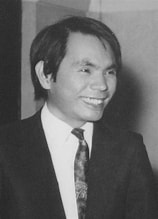Information is attributed to Professor Theodore Kim & Dr. Yoehan Oh

Bui Tuong Phong, 1969
Today, SGI welcomed the incredible Professor Theodore Kim from Yale University, as well as postdoctoral associate Dr. Yoehan Oh, for a Zoom presentation that was just as unique as it was important. While Fellows are spending much of our time focused on the technical side of things, today we took a step back to appreciate the history of a man who deserves more appreciation. With impressive alternation between each of their slide presentations, Professor Kim and Dr. Oh discussed the far-reaching legacy—yet far-too-short life—of Bui Tuong Phong.
Bui Tuong Phong was born in 1942 in Hanoi, Vietnam, but later moved to Saigon in 1954. His history is deeply connected to the Vietnam War—known as the American War in Vietnam. During this time, herbicides with major carcinogens were sprayed in Vietnam, especially in Saigon, while he lived there. It is quite likely that he was exposed.
Bui Tuong eventually left Saigon after being admitted to the Grenoble Institute of Technology in Grenoble, France. He later studied in Paris, and married his wife in 1969. In 1965, the Hart-Cellar Act significantly altered immigration laws in the United States, and he was able to move there. Moreover, the founding of Utah’s CS Division in 1954 provided him with additional support to begin pursuing a PhD at the University of Utah.
After graduation, Bui Tuong taught at Stanford as an adjunct teaching fellow, before his tragically early death in 1975. His cause of death is not known for certain, but the highest possibilities are leukemia, lymphoma, or squamous cell carcinoma. It is quite likely that American war efforts in Vietnam, such as the aforementioned carcinogenic herbicides, may have contributed to his early passing.
Despite all of his efforts, Bui Tuong never got to see how much his work impacted the world. He created the famous Phong shading model and reflection algorithms. Starting with rough shading on a mesh, Bui Tuong interpolated the surface normals to smooth it out, producing a much more realistic and clean mesh. This Phong shading is now the go-to method! Phong reflection added shine in a way that 3D-animated-film-viewers had never seen before—it was satisfyingly realistic. Phong reflection proved to be rather difficult to implement because the position of the viewer’s eye is necessary. Even so, Phong reflection can be seen everywhere now–even in media as popular as Toy Story!
Despite his undeniable contributions to graphics and the entertainment industry, it seems that many are too quick to forget the man behind these contributions. Within mere years of his death, many textbooks and papers even cited his name incorrectly, confusing each of the three parts in his name. After finding such inconsistencies during their research, Professor Kim and Dr. Oh contacted Bui Tuong’s daughter and wife. They confirmed that his family name is Bui Tuong (which can also be correctly written as Bui-Tuong) and his given name is Phong. This raises some interesting questions, like why are Phong shading and reflection named after his given name? Was it Bui Tuong’s own decision, or yet another case of others not taking the time to determine Bui Tuong’s family name vs. given name? Moreover, the top search result photographs allegedly of Bui Tuong are actually not of him at all; rather, they are of an entirely different man who just happens to share Bui Tuong Phong’s given name.
In the profound-yet-saddening words of Dr. Jacinda Tran, “It’s such a cruel irony considering the legacy that [Bui Tuong Phong] left behind: he’s advanced more realistic renderings in the digital realm and yet his own personhood has been so woefully misrepresented.”
Thank you to our guest speakers today for sharing such a moving and important story—and let it be known that Bui Tuong Phong was a man robbed of many years of life, but his incredible legacy lives on.